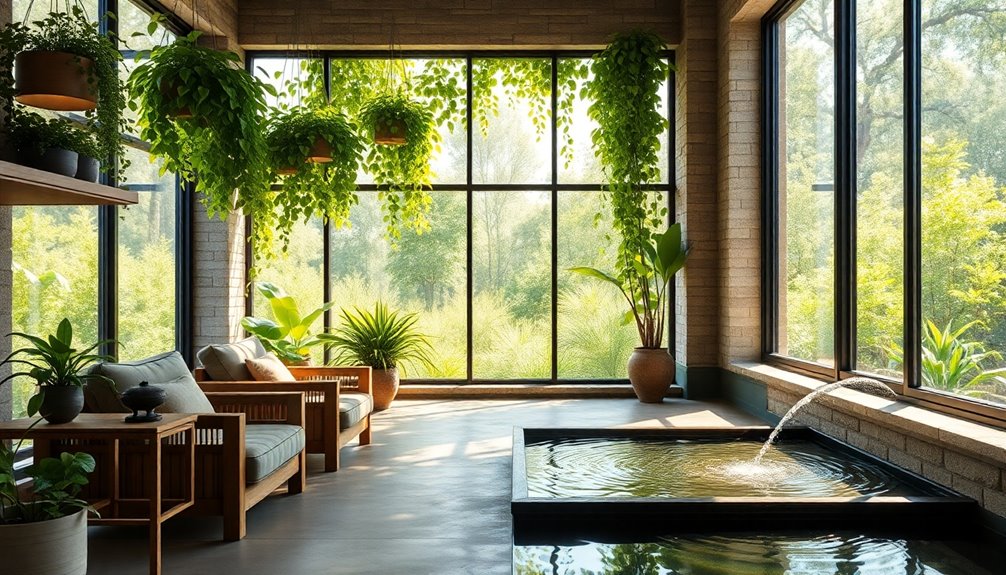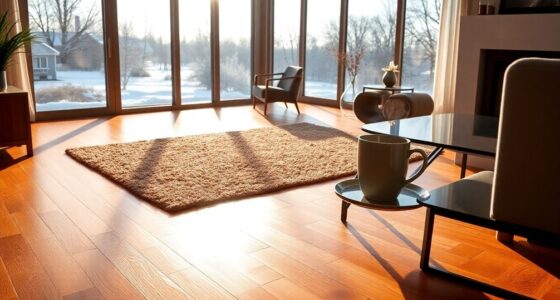Biophilic design is all about bringing nature indoors. It connects you to natural elements like sunlight, greenery, and fresh air, which can notably boost your mood and overall well-being. This design encourages calmness and creativity while enhancing productivity. You’ll find that spaces with biophilic features improve air quality and reduce stress. Embracing these principles can transform your environment into a healthier and happier place. Discover how these concepts can be further applied to enhance your spaces.
Key Takeaways
- Biophilic design reconnects people to nature, enhancing well-being through natural elements, greenery, and light in built environments.
- Incorporating nature improves air quality, reduces stress, and boosts cognitive function, productivity, and creativity in indoor spaces.
- Natural light regulates circadian rhythms, enhances mood, and promotes better sleep, contributing to improved mental health and comfort.
- Indoor plants and natural materials foster tranquility, visual appeal, and a calming atmosphere, creating a seamless connection to the outdoors.
- Economic benefits include increased productivity in workplaces, improved learning in educational settings, and faster recovery in healthcare environments due to biophilic design.
Understanding Biophilic Design
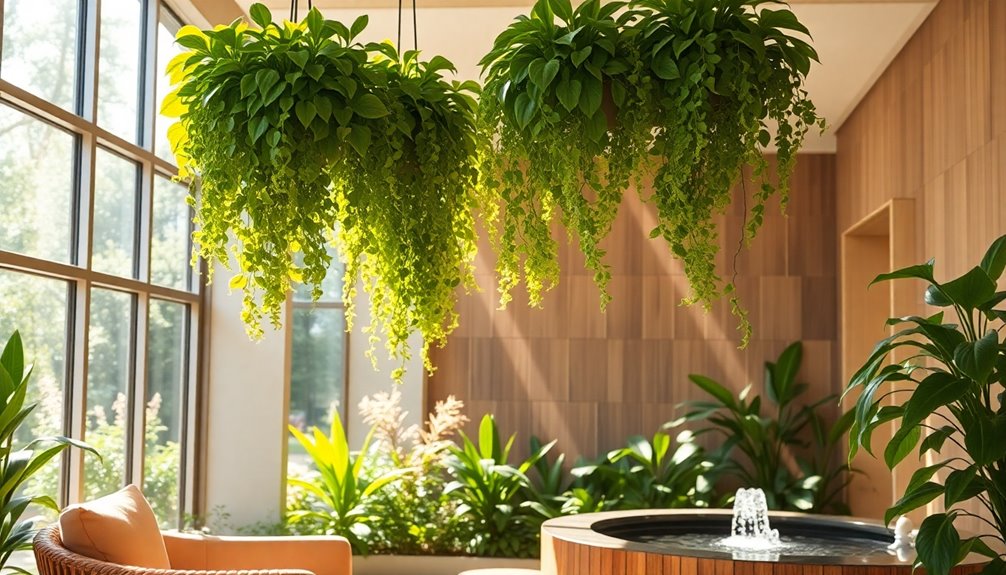
As you explore the concept of biophilic design, you’ll find it emphasizes reconnecting people with nature by weaving natural elements into our built environments.
This approach fosters a strong connection to nature, especially in indoor spaces where you spend much of your time. By incorporating greenery, using natural materials, and maximizing natural light, biophilic design enhances your environment and well-being.
Biophilic design strengthens our bond with nature, enriching indoor spaces with greenery, natural materials, and abundant light for enhanced well-being.
Research shows that these practices improve air quality and reduce stress, ultimately leading to significant health benefits. Additionally, introducing non-toxic XL houseplants can create a safe and vibrant atmosphere that enhances the aesthetic appeal of your indoor spaces.
The timeless relevance of this design philosophy, rooted in humanity’s innate “biophilia,” highlights the importance of creating spaces that nurture your mind and body.
Embracing these principles can transform your daily surroundings into healthier, more inspiring places to live and work.
The Benefits of Connecting With Nature
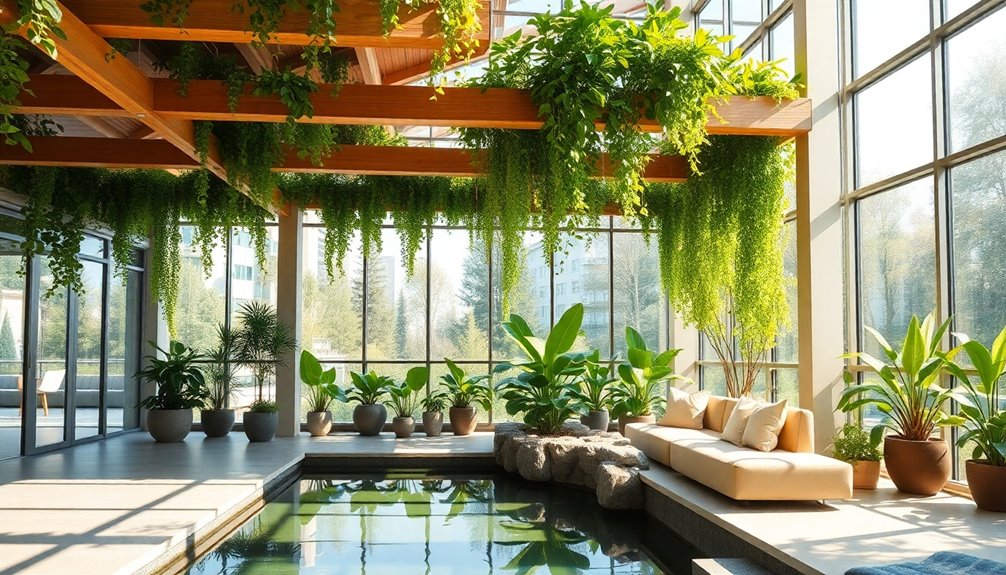
Integrating biophilic design into your environment not only enhances aesthetics but also brings numerous benefits to your mental and physical health. Connecting with nature through elements like indoor plants and natural light can considerably reduce stress, improving your overall well-being.
This connection promotes better air quality, which is essential for maintaining health. Additionally, studies show that exposure to natural elements boosts cognitive function, leading to increased productivity and creativity in your work environment.
You’ll also notice a positive impact on your mood and quality of life, enhancing job satisfaction and retention. Moreover, engaging with nature can aid in healing; patients with natural views recover 8.5% faster, illustrating how critical this connection truly is. Furthermore, incorporating sun protection education in outdoor spaces can further enhance health benefits by promoting safe sun practices.
Core Principles of Biophilic Design
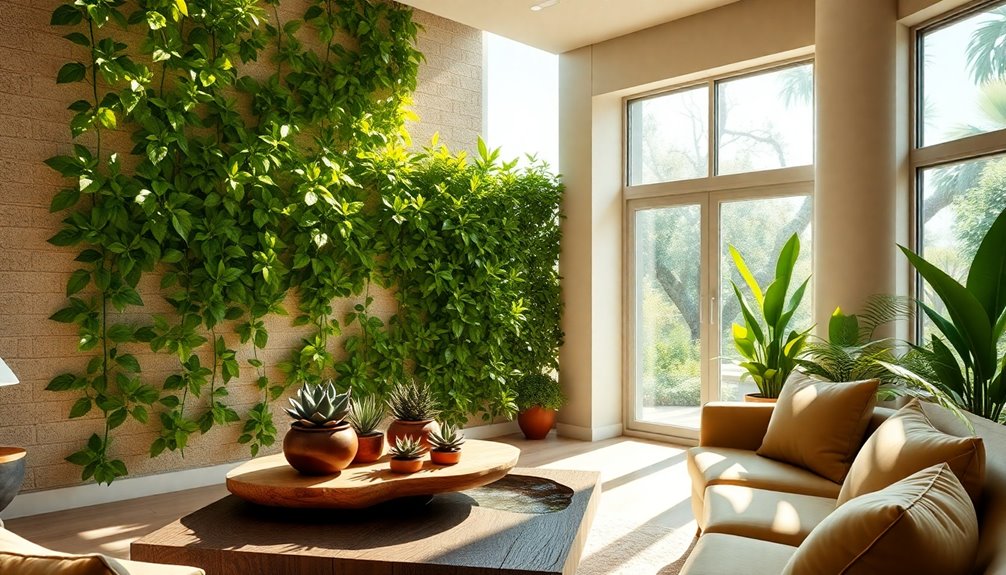
When you think about biophilic design, consider how natural light, indoor greenery, and natural materials can transform your space.
By maximizing sunlight, incorporating plants, and using elements like wood and stone, you create an environment that feels both inviting and calming.
These core principles not only enhance aesthetics but also boost your mood and well-being. Additionally, incorporating sustainable materials into your design can further promote a healthier living environment.
Natural Light Utilization
Natural light plays an essential role in biophilic design, enhancing your space’s overall atmosphere and well-being. By maximizing natural light, you create visual connections to the natural environment, fostering a sense of tranquility and connection to nature.
Studies show that ample natural light can greatly boost your productivity and cognitive function, improving employee performance by 20%. Additionally, well-lit spaces promote health and well-being by enhancing indoor air quality and encouraging ventilation, which helps reduce mold growth.
This sustainable approach also lowers energy costs, as it decreases reliance on artificial lighting. Embracing natural light in your design not only enriches your living environment but also contributes to a healthier, happier life. Furthermore, utilizing solar energy solutions can significantly reduce overall energy consumption and promote sustainability in your space.
Indoor Greenery Integration
Integrating indoor greenery is essential for creating a biophilic design that enhances your environment.
Here are some key benefits:
- Improves air quality and humidity levels
- Elevates mental well-being and reduces stress
- Boosts cognitive functioning and productivity
- Adds aesthetic appeal with living walls
- Incorporating natural elements can further enhance the positive effects of biophilic design.
Natural Materials Incorporation
Incorporating natural materials into your space not only enhances its aesthetic appeal but also fosters a deeper connection to nature. By using sustainable and eco-friendly options like reclaimed wood, stone, and bamboo, you can improve air quality and create a warm atmosphere in indoor environments.
Biophilic design principles encourage integrating living walls and vertical gardens, which utilize these natural materials to boost visual appeal and purify the air. These elements evoke calmness and tranquility, reducing stress while promoting overall well-being.
Research shows that environments enriched with natural materials can also increase productivity and creativity, making them ideal for both residential and commercial spaces. Embrace natural building practices to transform your surroundings into a rejuvenating sanctuary. Additionally, using eco-friendly materials in your design aligns with sustainable practices that benefit both the environment and your indoor space.
Integrating Natural Elements in Interior Spaces
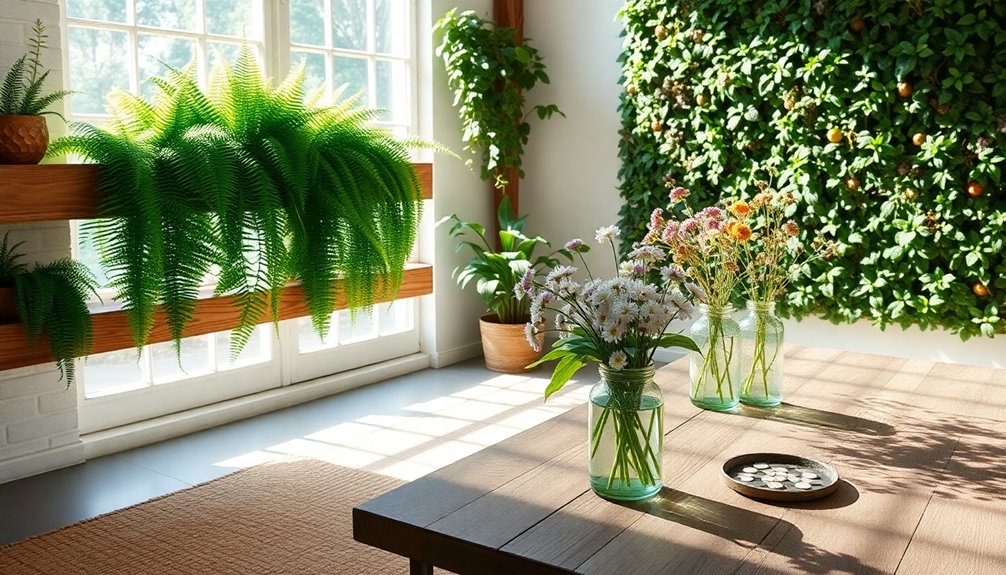
When you bring natural elements into your interior spaces, you not only boost aesthetics but also enhance your well-being. Embracing biophilic design can transform your environment and improve your health. Consider these ideas:
- Add indoor plants to improve air quality and create a calming atmosphere.
- Use natural materials like wood and stone for warmth and texture.
- Incorporate water features, such as fountains, to mimic nature’s soothing sounds.
- Include nature-inspired patterns in decor to foster a connection to the outdoors.
- Implementing natural materials can promote tranquility and enhance visual appeal.
The Role of Natural Light and Air Quality
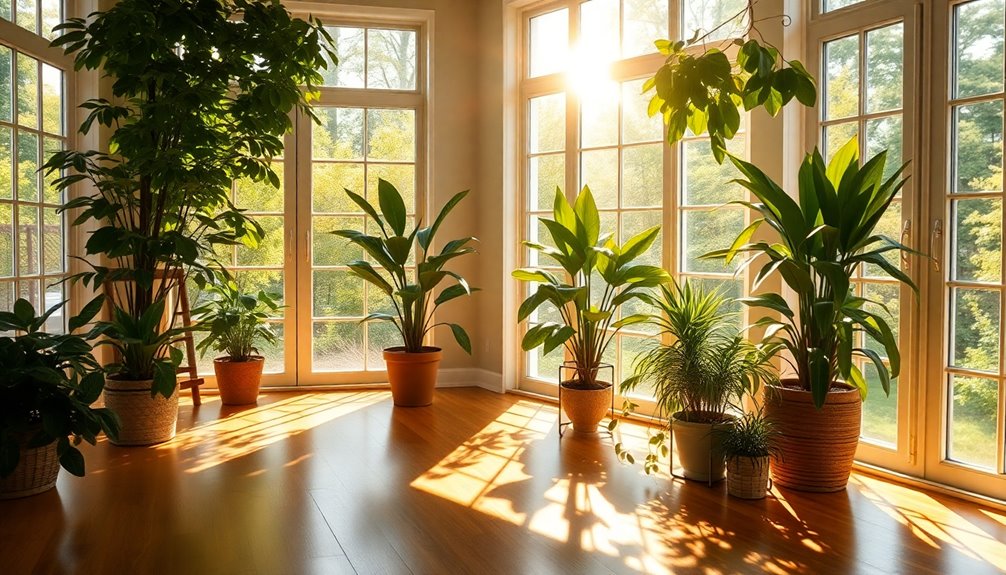
Natural light and fresh air can transform your workspace into a more uplifting environment.
With increased exposure to sunlight, you’re likely to feel more energized and productive, while good air quality keeps you comfortable and focused. Together, these elements not only support your health but also enhance your overall work experience. Additionally, incorporating air purifiers with HEPA filtration can significantly improve the air quality by removing allergens and pollutants.
Enhancing Mood and Productivity
Access to natural light and good air quality can dramatically enhance your mood and productivity.
Studies show that employees exposed to daylight report a 15% boost in well-being and productivity.
Here’s how these elements contribute to your work environment:
- Regulates circadian rhythms, improving sleep and mental health
- Enhances cognitive performance by up to 61% in well-ventilated spaces
- Increases focus and creativity during work hours
- Promotes well-being with the addition of indoor plants for better air quality
Incorporating biophilic design features like large windows and natural ventilation not only elevates your mood but also reduces absenteeism by 20%. Additionally, fostering a culture of shared responsibility can further enhance team collaboration and productivity in a biophilic workplace.
Prioritizing natural light and air quality is key to fostering a productive and healthy workplace.
Health Benefits of Air Quality
The link between air quality and your health can’t be overstated. Incorporating biophilic design elements, like natural materials and indoor plants, can enhance indoor air quality by reducing airborne toxins. This improvement leads to healthier living environments, which are essential for promoting health.
Exposure to nature and natural light not only boosts your mood but also regulates circadian rhythms, increasing serotonin production. You’ll experience significant drops in eyestrain and headaches when surrounded by ample natural light.
Furthermore, proper ventilation helps improve indoor air quality by up to 30%, reducing respiratory issues. Finally, spending time in these environments can lower cortisol levels by 14%, fostering stress reduction and creating a calming atmosphere for your daily life. Additionally, using an air purifier with HEPA filters can further enhance air quality by removing harmful pollutants and allergens.
Case Studies of Successful Biophilic Design

Biophilic design has gained traction across various architectural projects, demonstrating its positive impact on occupant well-being and environmental sustainability.
Biophilic design is increasingly recognized for enhancing occupant well-being and promoting environmental sustainability in architecture.
Here are some compelling case studies showcasing successful implementations:
- The Bullitt Center in Seattle, renowned for its large glass walls, enhances natural light and air quality.
- Denver’s Lakehouse condominium combines natural stone and wood with expansive windows, fostering a strong connection to nature.
- Thessalonica Court in the Bronx integrates community gardens, promoting health and well-being among residents.
- Skid Row Housing Trust projects merge housing with social services, prioritizing wellness and environmental connection.
These examples illustrate how biophilic design can elevate both indoor and outdoor spaces, boosting employee productivity and enhancing overall quality of life.
Economic Impacts of Biophilic Design
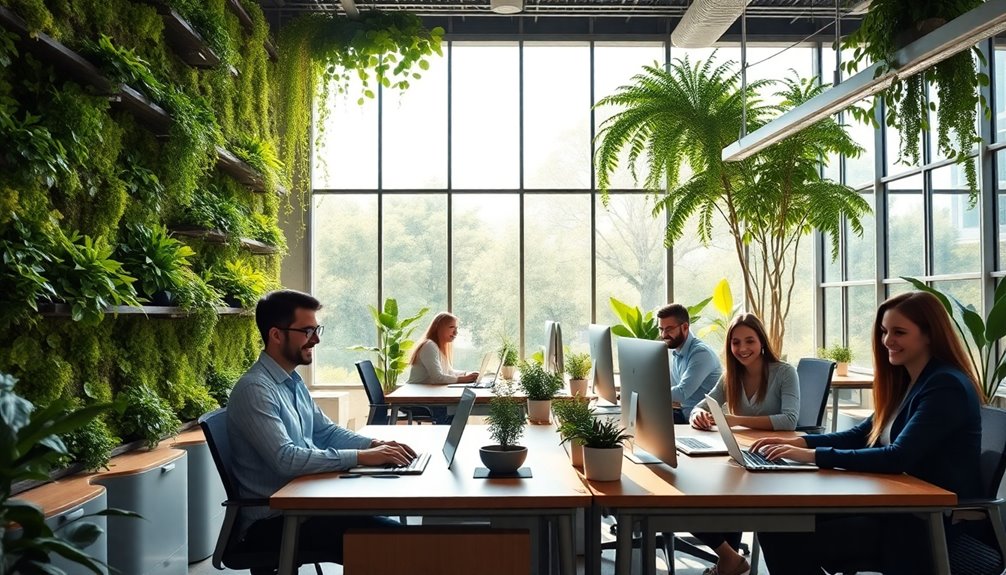
As you explore the economic impacts of biophilic design, you’ll find that its benefits extend far beyond aesthetics. Implementing biophilic elements can markedly boost visitor spending by up to 20% in retail spaces, showcasing its economic potential.
In healthcare, environments infused with nature can reduce recovery times by 8.5%, leading to lower healthcare costs. Workplaces that adopt biophilic design experience a 6-12% increase in productivity, translating into substantial financial gains.
Additionally, educational facilities incorporating these designs see a 15% improvement in learning speed, enhancing educational outcomes and reducing long-term costs.
Finally, the rise of wellness-oriented properties signals a new market trend, with these homes commanding higher prices and attracting buyers focused on health and well-being.
The Future of Biophilic Design in Urban Environments
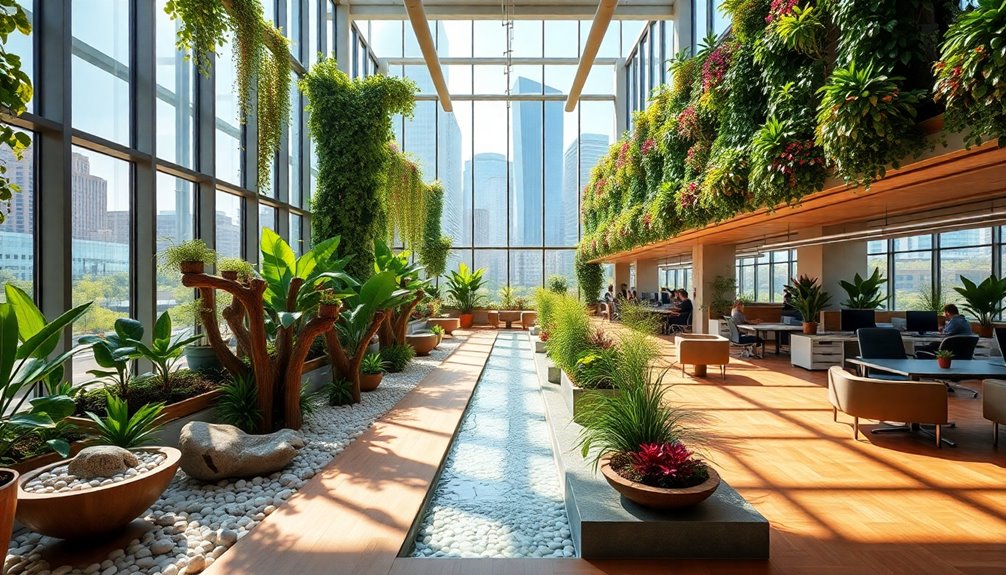
Integrating natural elements into urban planning is essential for creating healthier, more livable cities.
The future of biophilic design will focus on enhancing urban environments through:
- Green roofs that improve air quality
- Healing gardens promoting mental health
- Wellness-oriented projects fostering community engagement
- Sustainable cities that prioritize nature
As urban populations grow, these features become crucial for resilience.
Studies show that access to nature can boost productivity and well-being.
Access to nature significantly enhances productivity and overall well-being, making it a vital element in urban design.
Large corporations and developers are recognizing this trend, investing in biophilic design to create spaces that not only look good but also support inhabitants’ health.
Frequently Asked Questions
What Is the Science Behind Biophilic Design?
Biophilic design revolves around your innate connection to nature. By incorporating natural elements into your spaces, you can reduce stress and enhance your well-being.
Studies show that exposure to natural light improves your mood and productivity, while indoor plants purify the air, boosting oxygen levels.
You’ll notice that views of nature can speed up recovery times in healthcare settings, emphasizing how essential these design principles are for your overall health and happiness.
What Is the Science Behind Biophilia?
Isn’t it ironic that you feel stressed in a world so filled with nature? The science behind biophilia shows you’re wired to connect with the natural world.
Studies reveal that being around plants and sunlight lowers stress, boosts productivity, and enhances cognitive function. You might even find that these natural elements help reduce anxiety and depression while promoting mental resilience.
Embracing nature isn’t just nice; it’s essential for your well-being.
What Is Biophilia Theory of Interior Design?
Biophilia theory in interior design emphasizes your innate connection to nature. It encourages you to incorporate natural elements like light, greenery, and water features into your spaces.
Why Is Biophilic Design Important in Interiors?
Biophilic design’s important in interiors because it brings the calming essence of nature indoors, enhancing your mental well-being.
Incorporating elements like plants and natural light can reduce stress and boost your productivity.
You’ll find that spaces filled with greenery improve air quality and cognitive function, making you feel more energized and focused.
Ultimately, creating a connection to nature within your environment fosters a healthier, more satisfying living or working space.
Conclusion
Incorporating biophilic design into your space can transform how you feel and function daily. Imagine stepping into a bustling office filled with living walls and natural light streaming through large windows—instantly, your productivity soars and stress melts away. By embracing nature indoors, you’re not just enhancing aesthetics; you’re boosting well-being and efficiency. As urban environments evolve, prioritizing biophilic design will create healthier, happier spaces for everyone. Let’s bring the outdoors in and thrive together!
